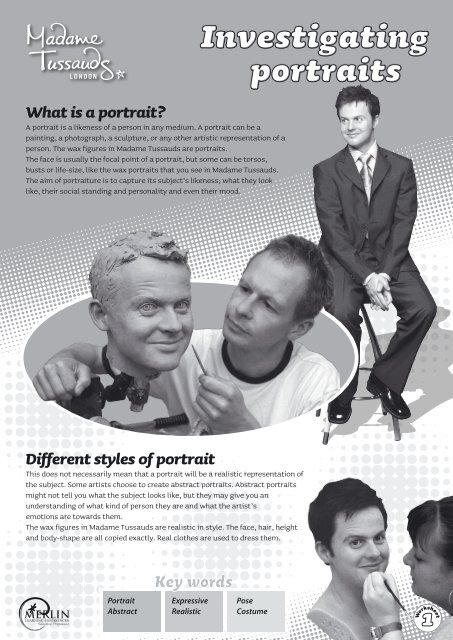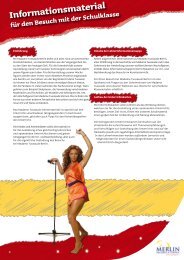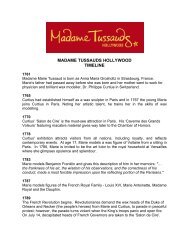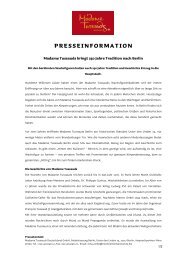What is a portrait? - Madame Tussauds
What is a portrait? - Madame Tussauds
What is a portrait? - Madame Tussauds
You also want an ePaper? Increase the reach of your titles
YUMPU automatically turns print PDFs into web optimized ePapers that Google loves.
<strong>What</strong> <strong>is</strong> a <strong>portrait</strong>?<br />
A <strong>portrait</strong> <strong>is</strong> a likeness of a person in any medium. A <strong>portrait</strong> can be a<br />
painting, a photograph, a sculpture, or any other art<strong>is</strong>tic representation of a<br />
person. The wax figures in <strong>Madame</strong> <strong>Tussauds</strong> are <strong>portrait</strong>s.<br />
The face <strong>is</strong> usually the focal point of a <strong>portrait</strong>, but some can be torsos,<br />
busts or life-size, like the wax <strong>portrait</strong>s that you see in <strong>Madame</strong> <strong>Tussauds</strong>.<br />
The aim of <strong>portrait</strong>ure <strong>is</strong> to capture its subject’s likeness; what they look<br />
like, their social standing and personality and even their mood.<br />
Different styles of <strong>portrait</strong><br />
Th<strong>is</strong> does not necessarily mean that a <strong>portrait</strong> will be a real<strong>is</strong>tic representation of<br />
the subject. Some art<strong>is</strong>ts choose to create abstract <strong>portrait</strong>s. Abstract <strong>portrait</strong>s<br />
might not tell you what the subject looks like, but they may give you an<br />
understanding of what kind of person they are and what the art<strong>is</strong>t’s<br />
emotions are towards them.<br />
The wax figures in <strong>Madame</strong> <strong>Tussauds</strong> are real<strong>is</strong>tic in style. The face, hair, height<br />
and body-shape are all copied exactly. Real clothes are used to dress them.<br />
Portrait<br />
Abstract<br />
Key words<br />
Expressive<br />
Real<strong>is</strong>tic<br />
Investigating<br />
<strong>portrait</strong>s<br />
Pose<br />
Costume<br />
Worksheet
Activity 1<br />
Look at these <strong>portrait</strong>s. Which are real<strong>is</strong>tic in style and<br />
which are expressive?<br />
Pablo Picasso - Portrait of Ambro<strong>is</strong>e-Vollard<br />
Pose, costume and<br />
background in <strong>portrait</strong>s<br />
The pose of a subject in a <strong>portrait</strong>, items in the background,<br />
and what they are wearing or holding can tell us<br />
a lot about them.<br />
H<strong>is</strong>toric <strong>portrait</strong>s can be particularly interesting. They can<br />
reveal a lot about how people lived, for example what their<br />
belief systems were, and what was in fashion at the time.<br />
Art top tips<br />
If you are going to be creating a <strong>portrait</strong>, keep notes on your<br />
subject. <strong>What</strong> do they wear? <strong>What</strong> do they do with their hair?<br />
<strong>What</strong> are their interests? <strong>What</strong> are your feelings about them?<br />
<strong>What</strong> do you think they are feeling? All these things will help<br />
you produce a <strong>portrait</strong> with lots of life to it.<br />
Investigating<br />
<strong>portrait</strong>s<br />
Eyck: Art<strong>is</strong>t's wife 1439. Credit: The Granger Collection / TopFoto<br />
Van Gogh: Postman 1889. Credit: The Granger Collection / TopFoto<br />
D.G. Rosetti: Beata Beatrix. Credit: The Granger Collection / Topfoto<br />
Did you know?<br />
There are wax figures of some of the most<br />
famous art<strong>is</strong>ts of all time at <strong>Madame</strong> <strong>Tussauds</strong><br />
London, including Pablo Picasso and Andy<br />
Warhol. Warhol created a unique style of<br />
<strong>portrait</strong>ure which was called ‘pop art’.<br />
Worksheet
Activity 1<br />
<strong>What</strong> do you think the poses and<br />
costumes of these <strong>Madame</strong> <strong>Tussauds</strong> wax<br />
figures tell us about their subjects?<br />
The importance of<br />
observation in <strong>portrait</strong>ure<br />
In order to produce a real<strong>is</strong>tic <strong>portrait</strong>, it <strong>is</strong> important to<br />
observe your subject closely.<br />
At <strong>Madame</strong> <strong>Tussauds</strong>, the wax figures are usually the result<br />
of one or more ‘sittings’. The celebrities are taken to a private<br />
purpose-built area, where our sculptors take prec<strong>is</strong>e measurements<br />
with a tape measure and a measuring instrument called ‘callipers’. Then they<br />
photograph the subject’s head and body from every possible angle. During the sitting, the<br />
sculptors also make observations that will help the sculpture show the celebrity’s personality.<br />
Sometimes it <strong>is</strong> not possible for subjects to come in for a sitting at <strong>Madame</strong> <strong>Tussauds</strong> (for example,<br />
when they are famous characters from h<strong>is</strong>tory!) and our<br />
sculptors will have to work from photographs or drawings<br />
of a character instead.<br />
Activity 2<br />
Look at these wax <strong>portrait</strong>s. Which<br />
of them do you think was sculpted<br />
following real-life observations<br />
and which from photographs<br />
or other reference material?<br />
Activity 3<br />
Do you think it <strong>is</strong> better to work from a photograph of your subject, or to<br />
have them sit for you in real-life? Sketch somebody you know from a<br />
photograph that you have at home (maybe a family member) and then<br />
ask one of your class-mates to pose for you and sketch them from<br />
real-life. Which was easiest? Which sketch was most like your subject?<br />
Sculptor<br />
Callipers<br />
Key words<br />
Observation<br />
Sketches<br />
Investigating<br />
<strong>portrait</strong>s<br />
Subject<br />
Wax<br />
Art top tips<br />
Keeping a sketchbook with you at all<br />
times and sketching quick<br />
observations of people that you see<br />
<strong>is</strong> great <strong>portrait</strong> practice. You may<br />
be able to use some of your sketches<br />
as the base for more developed<br />
pieces of work at a later date.<br />
Worksheet
A self-<strong>portrait</strong> <strong>is</strong> a piece of art<strong>is</strong>tic work, in which<br />
the art<strong>is</strong>t creates a likeness of themselves.<br />
Self-<strong>portrait</strong>s can often tell us a lot about how<br />
an art<strong>is</strong>t perceives themselves, or how they<br />
would like to be perceived by others.<br />
Activity 1<br />
Can you name three famous art<strong>is</strong>ts<br />
who have created self-<strong>portrait</strong>s?<br />
Talk about it with the person next<br />
to you if you need to.<br />
Activity 2<br />
Look at the self-<strong>portrait</strong>s to the right .<br />
<strong>What</strong> can we tell about the art<strong>is</strong>ts and<br />
their lives from their work? Look at the<br />
background, the art<strong>is</strong>t’s clothes and the<br />
way they have used their materials.<br />
Activity 3<br />
Choose a self-<strong>portrait</strong> that you like and<br />
study it in detail. Look at the following<br />
aspects of the work and make notes under<br />
each heading.<br />
Content - what <strong>is</strong> shown in the <strong>portrait</strong>?<br />
Form - How are they posed? <strong>What</strong> angle<br />
has the art<strong>is</strong>t chosen to paint<br />
themselves from? How are they<br />
positioned in relation to the background?<br />
How the artwork has been made – what<br />
kind of techniques, materials and<br />
processes has the art<strong>is</strong>t used?<br />
Effect – how does the self-<strong>portrait</strong> make<br />
you feel?<br />
Self-<strong>portrait</strong><br />
Content<br />
Form<br />
Marc Chagall: Self-<strong>portrait</strong>. Credit: Lu<strong>is</strong>a Ricciarini / TopFoto<br />
Key words<br />
Technique<br />
Collage<br />
Scrap-book<br />
Self-<strong>portrait</strong>s<br />
Vincent Van Gogh: Self-<strong>portrait</strong> with cut ear.<br />
Credit: Roger-Viollet / TopFoto<br />
<strong>What</strong> can we tell about:<br />
their personality<br />
their mood and emotions<br />
how they perceive themselves<br />
what time in h<strong>is</strong>tory the<br />
painting was produced in<br />
what they were trying to show?<br />
Art top tips<br />
Collect photographs and items that are important to you<br />
(e.g. pictures of friends and family, images of your hobbies<br />
and interests). Use them to make a creative collage. Th<strong>is</strong><br />
will help you to build a ‘picture’ of yourself to support<br />
your work around self-<strong>portrait</strong>s. Refer to<br />
art<strong>is</strong>ts such as Rauschenberg or<br />
information on the craft of<br />
scrap-booking to guide you.<br />
Materials<br />
Processes<br />
Worksheet
Activity 1<br />
How would you describe the shape of your face?<br />
<strong>What</strong> shape are your eyes?<br />
Describe your nose and mouth.<br />
Activity 2<br />
Developing a<br />
self-<strong>portrait</strong><br />
Describe your face as you see it in a mirror. On a separate piece of paper, record the following details:<br />
<strong>What</strong> <strong>is</strong> your hair like?<br />
<strong>What</strong> <strong>is</strong> your skin tone? Describe what colours<br />
you might use to mix it as a paint colour.<br />
At <strong>Madame</strong> <strong>Tussauds</strong>, the sculptors use tape measures and callipers to measure every part of their subject’s face and<br />
body before creating their wax figure. You will have to rely on your powers of observation to make sure that your<br />
self-<strong>portrait</strong> <strong>is</strong> accurate. Use a mirror to help you draw a self-<strong>portrait</strong>. Follow instructions 1 – 4 below to help you.<br />
1 2<br />
Draw a horizontal line to show the level of your<br />
eyes. Draw a second line to mark the bottom of<br />
your nose. Eyes are always halfway between the<br />
top of the head and the bottom.<br />
3 4<br />
Draw five ovals across<br />
the eye line.<br />
Draw a vertical line of symmetry.<br />
Draw a third line to show where your mouth<br />
appears. The mouth <strong>is</strong> around halfway between<br />
the nose and the the bottom of the face.<br />
Draw in the shape of<br />
your face.<br />
Draw in the shape of your face.<br />
Worksheet
Activity 1<br />
a<br />
b<br />
When you have fin<strong>is</strong>hed your self-<strong>portrait</strong>, look at it closely.<br />
Does it look like you? If not, why not? <strong>What</strong> could you<br />
develop or alter to make it look even better?<br />
Swap <strong>portrait</strong>s with the person sitting next to you. <strong>What</strong><br />
are the best things about their <strong>portrait</strong>? Give them some<br />
tips on how they might develop it further.<br />
Activity 2<br />
Many art<strong>is</strong>ts have created self-<strong>portrait</strong>s which show their<br />
mood or feelings (e.g. Picasso, Rembrandt, Van Gogh).<br />
Create a self-<strong>portrait</strong> that expresses a particular feeling or<br />
mood. You could use colour, marks and textures to suggest<br />
what that feeling or mood might be.<br />
For example:<br />
1<br />
2<br />
3<br />
4<br />
Dark, heavy marks or sharp shapes might suggest anger or pain.<br />
Pale, delicate marks might suggest uncertainty.<br />
Pale colours or a lot of blue might suggest sadness or calm.<br />
A lot of bright, vibrant colours might suggest happiness.<br />
You might also like to use symbols to suggest a mood or emotion.<br />
Look at the work of Frida Kahlo. She was a Mexican art<strong>is</strong>t who<br />
experienced a lot of physical and emotional pain in her life and<br />
she often used symbols in her work to reflect that pain.<br />
Activity 3<br />
Write a poem to go with your painting,<br />
expressing the same feeling or mood.<br />
Activity 4<br />
Swap self-<strong>portrait</strong>s with one of your<br />
classmates and evaluate each other’s<br />
work. Think about the following:<br />
Can you tell what mood or emotion<br />
<strong>is</strong> shown in the image?<br />
Is the composition of the picture<br />
effective?<br />
Symbols<br />
Evaluation<br />
Developing a<br />
self-<strong>portrait</strong><br />
Art top tips<br />
Make a number of observational studies of yourself using different drawing<br />
media. Look at how your face changes depending on your expression.<br />
Creating a likeness of somebody, especially yourself, <strong>is</strong> a challenge, but fun.<br />
The more you practice though, the better you will get!<br />
Looking at, and analysing other art<strong>is</strong>ts’ work <strong>is</strong> a great<br />
way of developing your own personal style. V<strong>is</strong>it as many<br />
galleries as you can and do research online, making<br />
notes and sketches on their styles and techniques all<br />
the time. The National Portrait Gallery’s website <strong>is</strong> a<br />
good source of information www.npg.org.uk<br />
Key words<br />
Style<br />
Vibrant<br />
Texture<br />
1<br />
Pablo Picasso:<br />
Self <strong>portrait</strong> 1901<br />
Credit: The Granger<br />
Collection / TopFoto<br />
2<br />
Pablo<br />
Picasso:<br />
Self Portrait<br />
at Age 26<br />
Credit: The Granger<br />
Collection / TopFoto<br />
Worksheet
Investigating <strong>portrait</strong>s<br />
- sculpture<br />
Creating a wax figure at <strong>Madame</strong> <strong>Tussauds</strong><br />
Activity 1<br />
1<br />
2<br />
Sculpture<br />
Steel<br />
Mould<br />
Detailed measurements<br />
and photographs of<br />
the subject are<br />
taken and a steel<br />
skeleton <strong>is</strong> made for<br />
the body.<br />
The sculptor uses these<br />
measurements to<br />
create a clay model of<br />
the subject’s head.<br />
Sculptors form the<br />
shape of the body<br />
over the steel<br />
skeleton using clay.<br />
Sculptures can be made from many different kinds of<br />
materials. At <strong>Madame</strong> <strong>Tussauds</strong> we use wax. Th<strong>is</strong> helps us<br />
to create the best likeness of the celebrities we are modelling.<br />
Other materials can be used in sculpture as well.<br />
Which of the following do you think would be best for sculpting<br />
<strong>portrait</strong>s and why?<br />
Glass<br />
Metal<br />
Clay<br />
Ice<br />
Wood<br />
Papier-mâché<br />
Plaster<br />
Key words<br />
Oil paint<br />
Clay<br />
Papier-mâché<br />
3<br />
4<br />
5<br />
Separate plaster moulds<br />
are then made of the<br />
head and body. A hot<br />
wax mixture <strong>is</strong> poured<br />
into the mould and left<br />
to cool and harden.<br />
The mould <strong>is</strong> carefully<br />
removed, leaving a<br />
cast of the wax<br />
figure. The head<br />
cast <strong>is</strong> then<br />
attached to<br />
the body.<br />
Teeth, hair and eyes are<br />
added to the <strong>portrait</strong><br />
and colour <strong>is</strong> applied to<br />
the wax skin using oil<br />
based paints. Paint <strong>is</strong><br />
applied in layers,<br />
creating a real<strong>is</strong>tic skin<br />
colour and texture.<br />
Worksheet
Activity 1<br />
Activity 2<br />
a<br />
You are going to create a sculpture of one of your<br />
classmates. You will need to think about the following:<br />
Who <strong>is</strong> your subject?<br />
Will you be working from photographs or real life?<br />
How would you plan a photo-shoot of your subject to help you<br />
with your sculpture?<br />
<strong>What</strong> kind of props might you use in your sculpture to show the<br />
character of the sitter (e.g. favourite hat, hoody etc.)?<br />
How will you pose your subject?<br />
<strong>What</strong> materials are available to you and how will you use them?<br />
Developing a sculptural<br />
self-<strong>portrait</strong><br />
At <strong>Madame</strong> <strong>Tussauds</strong>, our guests can walk up to their favourite celebrity figure and walk<br />
around them. It <strong>is</strong> important to create a good likeness from all angles. Use a wooden<br />
manikin to help you practice representing figures from a number of angles.<br />
Sketch the figure from the front. Now move the manikin. Sketch it<br />
from a sideways angle.<br />
Art top tips<br />
Researching your subject well before you start can really help you with creating<br />
your sculptural self-<strong>portrait</strong>. Collect information about them (v<strong>is</strong>ual and nonv<strong>is</strong>ual)<br />
and make a number of sketched studies from different angles so that you<br />
really get to know how they look from all sides.<br />
b c<br />
Move the manikin to a reverse facing<br />
position. Sketch it from behind.<br />
Did you know?<br />
It can take up to three weeks to<br />
insert all the hair into the head of a<br />
<strong>Madame</strong> <strong>Tussauds</strong> wax figure, with<br />
the hair inserters working in<br />
shifts day and night!<br />
Worksheet
Activity 1<br />
Once you have developed a portfolio of sketches and your planning<br />
sheet, you are ready to create your sculpture, thinking about the<br />
following:<br />
Scale – how big will your piece be?<br />
Techniques – what techniques will you use to build the 3D form?<br />
Texture – will your piece be smooth or textured? Will some<br />
parts of the sculpture need a different texture like skin or hair?<br />
Colours – how will you fin<strong>is</strong>h off the surface of the piece?<br />
Will you stain it or paint it? D<strong>is</strong>cuss the possibilities with<br />
your teacher. If you are going to stain or paint your<br />
sculpture at a later stage, make notes or record sample<br />
colours to make sure that you can match the colours.<br />
Art top tips<br />
When painting your sculpture, start with lighter<br />
colours. It <strong>is</strong> easier to start light and continue layering<br />
paint on until the end result <strong>is</strong> darker rather than<br />
starting darker and trying to take your colour lighter.<br />
Activity 2<br />
Developing a sculptural<br />
self-<strong>portrait</strong><br />
Everybody has different tones to their skin, hair, eyes and teeth and all these need to be recorded when creating a<br />
sculpture. The colour<strong>is</strong>ts at <strong>Madame</strong> <strong>Tussauds</strong> have a palette with various flesh tone colours. These are oil based<br />
paints that are mixed to achieve an exact match to the celebrity’s colouring.<br />
If you have sculpted your model from clay, papier-mâché or modroc, it will now need painting.<br />
Mix up your paints to achieve the right tones for your sculpture. Use the notes / sample colours that you took<br />
when creating your sculpture for reference. You may find you need to use blue or even green for the basic skin<br />
colour for a particular area.<br />
You may choose to use colour expressively rather than real<strong>is</strong>tically.<br />
You will still need to consider which colours work together and which<br />
contrast to achieve a successful result.<br />
Think about how you will apply the paint. Will you put it on smoothly<br />
with a brush? Will you use a sponge for application? Will you tap the<br />
paint off the brush to create a spatter effect?<br />
Apply the paint carefully to your sculpture. There are many different<br />
colours in skin. You may need to build up several layers of colour to<br />
achieve a real<strong>is</strong>tic effect.<br />
key Words<br />
Scale Palette Skin tone<br />
Did you know?<br />
<strong>Madame</strong> <strong>Tussauds</strong> was founded in<br />
the 1800s by a lady called Marie<br />
'Grosholtz' who later became<br />
<strong>Madame</strong> <strong>Tussauds</strong>. Back in the early<br />
1800s there was no TV, radio or<br />
magazines, so most images of<br />
celebrities at the time were painted<br />
<strong>portrait</strong>s or sculptures. <strong>Madame</strong><br />
<strong>Tussauds</strong> created exact replicas of<br />
famous people in three<br />
dimensions; the techniques<br />
she used are still used today.<br />
Worksheet










